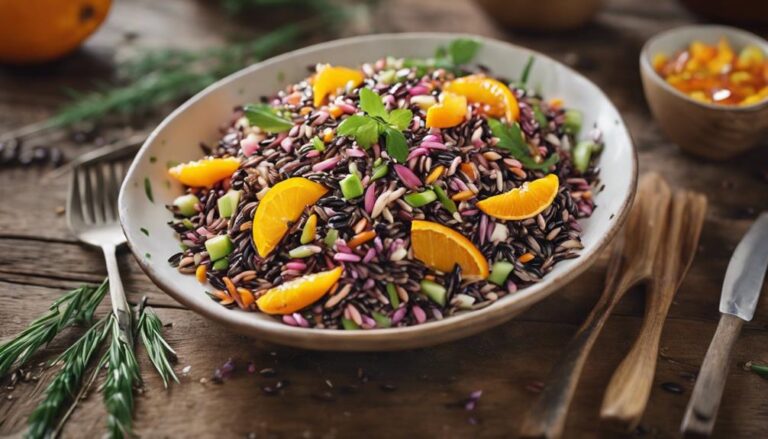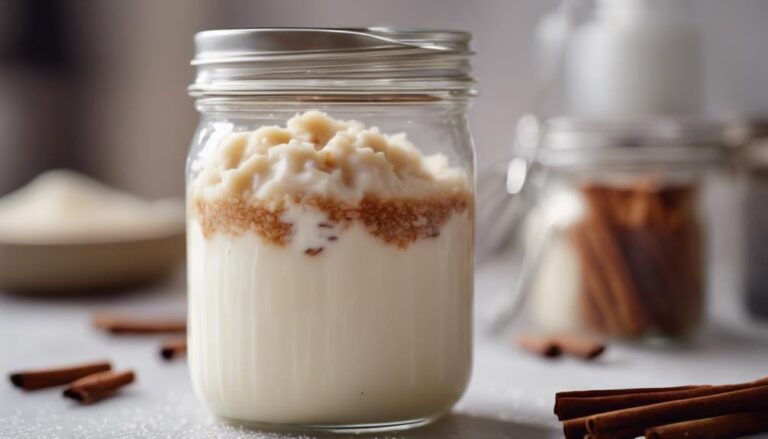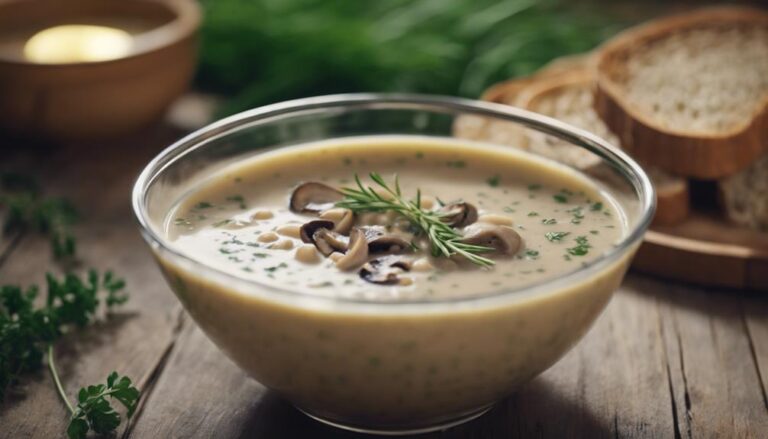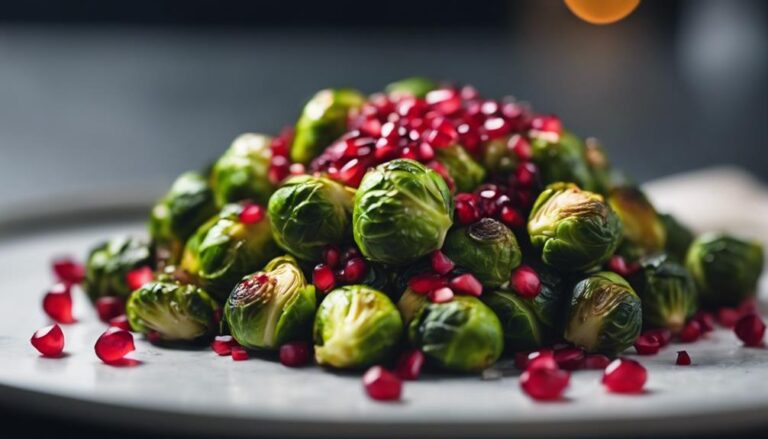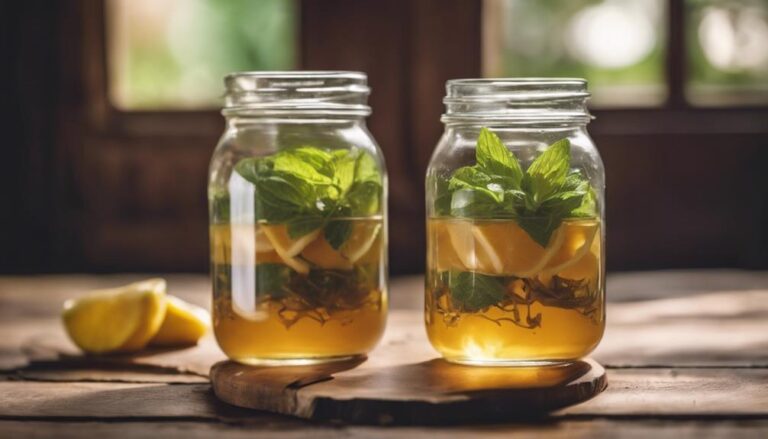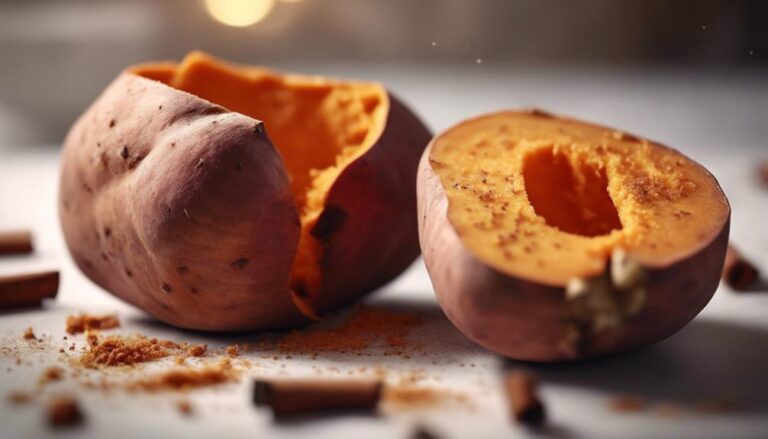Sous Vide Poached Pears With Agave Syrup
Achieve the perfect tenderness by sous vide poaching ripe Bosc pears with agave syrup. Guarantee a firm texture while infusing natural sweetness. Experiment with different spices to enhance flavor variations. Adjust cooking times between 30 to 60 minutes for best results based on pear ripeness. Maintain precise water bath temperature at 80°C/176°F for flavor infusion. Agave syrup delicately complements the pear's essence without overpowering. Pair with vanilla ice cream for a delightful contrast. Elevate with red wine reduction for a sophisticated twist. Enhance your culinary skills and experience innovative flavor combinations with sous vide poached pears and the subtle touch of agave syrup.
What You Will Learn Here
- Bosc pears are best for sous vide poaching, maintaining texture and sweetness.
- Sous vide cooking preserves flavors, creating harmonious pear dishes.
- Adjust sous vide cooking times based on pear variety and ripeness.
- Agave syrup enhances poached pear sweetness without overpowering flavors.
- Serve poached pears with ice cream or red wine reduction for a gourmet touch.
Pear Cultivation Origins
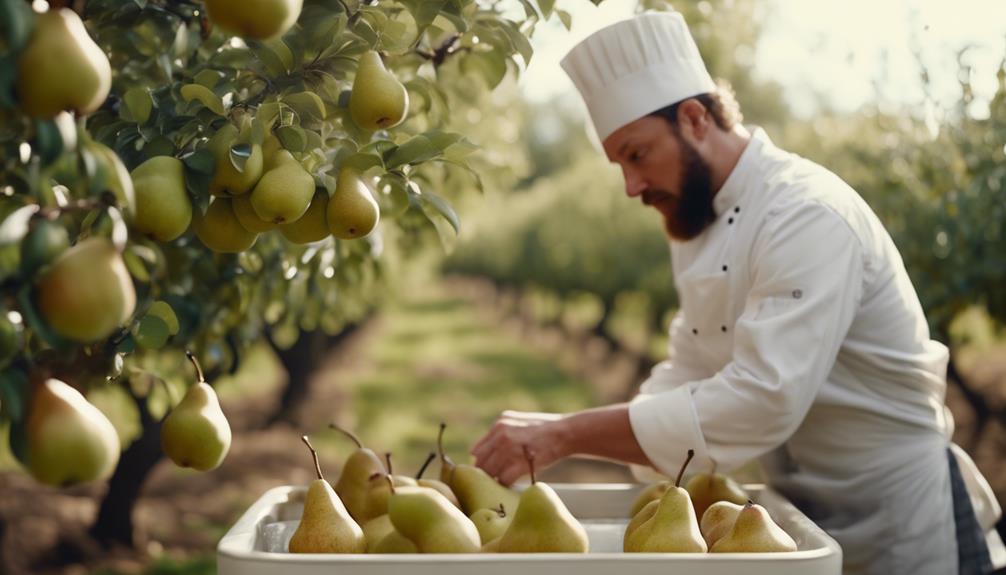
Pears trace their cultivation origins back to ancient China, where they've been grown for millennia.
The spread of pear cultivation across continents, evolving through different varieties suited to diverse climates, reflects a rich history of agricultural development.
Understanding the historical roots of pear cultivation sheds light on the fruit's adaptability and significance in various cultures.
Pear Cultivation Origins
Believed to have originated in the Caucasus region near modern-day Armenia, the cultivation of pears has a rich history dating back centuries. Pears have been highly esteemed since ancient times, with the Greeks and Romans valuing them for their sweetness and rich flavor.
European settlers introduced pear trees to North America in the 17th century, contributing to the fruit's global spread. Today, China stands as the largest producer of pears worldwide, closely followed by Italy and the United States.
Pears are a versatile fruit, finding their way into various culinary creations, including desserts, salads, and savory dishes. The journey of pear cultivation showcases how this fruit has transcended borders and become an integral part of diverse cuisines across the globe.
Historical Pear Cultivation
Having originated in the Caucasus region near modern-day Armenia, the cultivation of pears has an extensive history spanning over 4,000 years, with significant contributions from ancient civilizations like the Greeks and Romans.
The ancient Greeks and Romans played a pivotal role in advancing pear cultivation techniques, influencing the spread of pear cultivation throughout Europe. European monks also made notable contributions to pear cultivation by preserving and propagating different pear varieties. Their meticulous work helped to maintain and enhance the diversity of pear cultivars.
This cultivation journey eventually led to the introduction of pear cultivation to North America in the 17th century by European settlers, further enriching the global landscape of pear varieties and cultivation practices.
Pear Cultivation Evolution
Originating from ancient civilizations in regions spanning Asia and Europe, the evolution of pear cultivation has been marked by a continuous refinement of techniques and the development of diverse varieties with distinct characteristics.
Modern agricultural practices have played a pivotal role in enhancing pear cultivation, improving quality, yield, and disease resistance. The adaptation to different climates and soil conditions has led to the proliferation of various pear varieties, each uniquely suited to specific environments.
Farmers and horticulturists have leveraged advancements in technology and scientific knowledge to propel the evolution of pear cultivation forward. This rich history showcases the intersection of tradition and innovation, culminating in the wide array of pear varieties available today.
The careful selection of poaching liquid and meticulous attention to detail highlight the dedication to serving exceptional pears to consumers.
Bosc Pears for Poaching
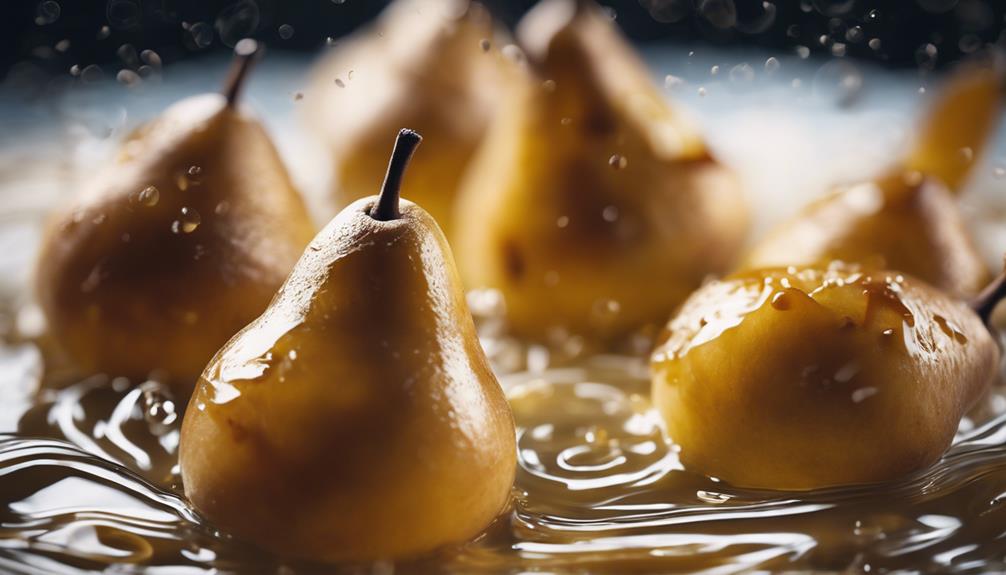
Bosc pears are renowned for their firm texture and sweet flavor, making them the top choice for poaching due to their ability to maintain shape and enhance the infusion of agave syrup. When selecting Bosc pears for poaching, make sure they're ripe but still slightly firm to withstand the cooking process. Here are some key points to keep in mind:
- Bosc pears are ideal for poaching because of their firm texture and ability to hold shape well during cooking.
- The natural sweetness of Bosc pears complements the agave syrup, creating a harmonious flavor profile.
- When poached sous vide with agave syrup, Bosc pears become tender while retaining their delicate flavor, resulting in a delectable dessert.
Sous Vide Pear Tartlets
When you consider the ASPECTS related to Sous Vide Pear Tartlets, you'll find a variety of elements to explore. From a delightful Pear and Ginger Compote to a INVIGORATING Ginger-Infused Pear Salad, and a decadent Pear and Honey Glaze, each point offers a unique twist to elevate your tartlets.
These components bring together different flavors and textures that harmonize perfectly in each bite, adding depth and complexity to your dessert.
Pear and Ginger Compote
For crafting delicious sous vide pear tartlets, the key lies in preparing a well-balanced pear and ginger compote that harmonizes sweet and spicy flavors perfectly.
- Versatile Filling: Use the pear and ginger compote as a flavorful filling for tartlets or as a delightful accompaniment to various desserts.
- Sous Vide Perfection: Sous vide cooking guarantees the pears are cooked to perfection and infused with the rich essence of ginger.
- Natural Sweetness: Agave syrup adds a touch of natural sweetness to the compote, complementing the delicate taste of pears without overwhelming it.
Ginger-Infused Pear Salad
To amplify the flavor profile of your sous vide pear tartlets, consider integrating a zesty twist with a ginger-infused pear salad.
Key Points:
- Ginger-infused pear salad combines the sweetness of poached pears with the spicy kick of ginger.
- Sous vide cooking guarantees the pears maintain their texture while being infused with the aromatic ginger.
- The harmonious balance of taste achieved through sous vide cooking creates a gourmet touch, elevating the overall dining experience.
Serving ginger-infused pear salad alongside sous vide pear tartlets not only highlights the precision of sous vide cooking but also provides an invigorating and sophisticated flavor combination. The infusion of ginger adds a unique twist to the classic poached pears, making this salad a delightful accompaniment to your dessert menu.
Pear and Honey Glaze
Enhancing the sous vide pear tartlets with a luscious pear and honey glaze guarantees the dessert's sweetness and visual appeal. Using poached pears infused with agave syrup adds a depth of flavor that complements the natural sweetness of the fruit. The sous vide cooking method guarantees that the pears absorb the agave syrup evenly, resulting in a tender and flavorful filling for the tartlets. Drizzling the glaze over the tartlets provides a glossy finish and a touch of sweetness without overpowering the delicate pear flavor. By incorporating this pear and honey glaze, you can create a sophisticated dessert that showcases the harmonious blend of poached pears and agave syrup in a sous vide cooking style.
- Agave syrup is a natural sweetener with a low glycemic index.
- Sous vide poached pears absorb flavors evenly.
- The glaze adds a glossy finish and sweetness.
Pear Poaching Time Suggestions
To achieve the ideal texture in your poached pears, stick to the suggested 20-30 minute poaching window.
Adjust the cooking time accordingly based on the ripeness of the pears to guarantee they reach peak tenderness.
Consistent cooking durations are crucial for uniform results and a delightful pear poaching experience.
Poaching Time Guidelines
Considering the ripeness of your Bartlett or Anjou pears, poach them sous vide at 175°F/70°C for 30-60 minutes to achieve ideal tenderness.
When using the sous vide method, guarantee the pears are placed in a vacuum-sealed bag to cook evenly. Monitoring the water bath temperature consistently throughout the cooking process is crucial to maintain precision.
By sealing the pears properly and cooking them at the recommended temperature range, you can achieve a uniform texture. Remember to check the pears periodically to determine their doneness.
To enhance the flavor profile, consider adding ingredients like vanilla bean seeds, sugar, zest, cardamom, or salt to the vacuum bag. Following these guidelines will result in perfectly poached pears ready to be enjoyed.
Optimal Cooking Durations
For ideal sous vide poaching results with agave syrup, adjust the cooking duration of Bartlett or Anjou pears based on their ripeness, ranging from 30 to 60 minutes.
The sugar in the agave syrup helps sweeten the pears, while the water in the sous vide bath guarantees even cooking.
To achieve the perfect texture and flavor infusion, maintain a consistent water bath temperature of 80°C/176°F throughout the cooking process.
Longer cooking times are recommended for firmer pears to soften them adequately.
By carefully monitoring the cook time and temperature, you can create tender, flavorful poached pears that are sure to delight your guests.
Experimenting with additional ingredients like spices or citrus peel in the agave syrup can offer exciting flavor variations.
Timing for Pear Tenderness
If you seek ideal pear tenderness when sous vide poaching, adjusting the cooking duration based on ripeness levels is essential for achieving desired results. Here are some general guidelines to assist you in determining the appropriate cooking times based on the ripeness of the pears:
| Pear Ripeness Level | Cooking Time Range |
|---|---|
| Firm | 45-60 minutes |
| Ripe | 30-45 minutes |
| Overripe | 20-30 minutes |
Final Thoughts
In conclusion, the addition of agave syrup in sous vide poached pears enhances a delicate sweetness that perfectly complements the inherent flavors of the fruit. The use of agave syrup, with its mild and slightly sweet profile, adds a nuanced layer of taste without overshadowing the pear's natural essence.
When serving these agave-infused poached pears, consider pairing them with a scoop of creamy vanilla ice cream to create a harmonious blend of textures and temperatures. For those seeking a more complex flavor profile, a reduction of red wine can elevate the dish by providing a sophisticated contrast to the sweetness of the pears and agave syrup.
While a basic sugar syrup can also be used in poaching pears, the unique characteristics of agave syrup offer a modern twist that caters to those looking for a lighter, more nuanced alternative. Ultimately, the incorporation of agave syrup in sous vide poached pears presents a delightful opportunity to explore innovative flavor combinations that are sure to impress your guests.
Frequently Asked Questions
Do You Have to Peel Pears Before Poaching?
You should peel pears before poaching to enhance texture and flavor infusion. Peeling aids in consistent texture, while leaving the peel on can offer a rustic touch and added nutrients. Presentation options vary based on peeling preference.
How Can You Keep the Pears Completely Covered by the Poaching Liquid?
To keep the pears fully submerged in the poaching liquid, make sure they are sealed in a bag with excess air pressed out. Utilize a weight to maintain immersion if needed. Monitor and adjust liquid levels as necessary for consistent coverage.
Why Do You Add Sugar to Water When Poaching Fruit?
When poaching fruit, you add sugar to water to create a solution that balances sweetness, enhances flavor, and preserves texture. The sugar concentration aids in syrup absorption, texture retention, and caramelization potential, culminating in a delightful culinary experience.
At Which Stage of Ripeness Should Pears Be for Poaching?
For peak ripeness when poaching pears, select fruit that's ripe but still firm. This stage guarantees they maintain shape and develop rich flavors. Overripe pears turn mushy, underripe ones lack sweetness. Perfectly ripe pears balance texture and taste in poached desserts.
Conclusion
To wrap up, sous vide poached pears with agave syrup provide a delicate and flavorful dessert option. By utilizing Bosc pears and precise poaching times, the outcome is tender, juicy, and perfectly cooked pears.
The gentle cooking method of sous vide guarantees that the pears maintain their natural sweetness and texture, while the agave syrup adds a touch of sweetness without overpowering the fruit.
This dessert is a sophisticated and elegant choice for any occasion.






